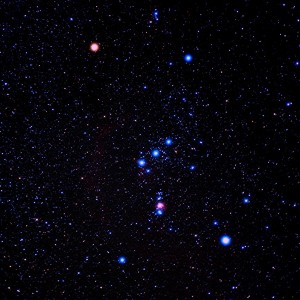 A couple of years ago, we moved out of the city, pretty close to the neighborhood I lived in through high school and college. I suppose, when I was a teenager/young adult, I didn’t spend a lot of time looking around outside at 5 in the morning. Now that I’m a growed-up, with growed-up responsibilities like a career and a dog with active bodily functions (but an unfenced yard) I find myself standing outside in the darkest part of the night fairly often — and I marvel at the brightness and clarity of the stars out there. On a clear night, you can fairly easily discern the color of stars, or whether they are pulsars, or whether they’re actually a sneaky planet or satellite instead of a true star.
A couple of years ago, we moved out of the city, pretty close to the neighborhood I lived in through high school and college. I suppose, when I was a teenager/young adult, I didn’t spend a lot of time looking around outside at 5 in the morning. Now that I’m a growed-up, with growed-up responsibilities like a career and a dog with active bodily functions (but an unfenced yard) I find myself standing outside in the darkest part of the night fairly often — and I marvel at the brightness and clarity of the stars out there. On a clear night, you can fairly easily discern the color of stars, or whether they are pulsars, or whether they’re actually a sneaky planet or satellite instead of a true star.
When I walk out my front door in the early morning, I step right into Orion. It’s my favorite constellation, for no better reason than it’s very visible in this part of the world, and I find it very easy to pick out. I always had trouble finding the Big Dipper, but I could always lock on to Orion.
I used to think that Orion only appeared in our night sky during the winter, but lately I’ve discovered that isn’t really true. I’m not sure where I got that idea. Is it a geographical thing? I grew up in Colorado and then moved to Idaho; maybe that was true of the former? Around here, you can find Orion somewhere in the sky pretty much year-round, although he is definitely at his most glorious in the winter… especially at 5 AM.
I love the name of it. Orion. It bridges that gap between exotic and approachable just perfectly: Not an English word, but not uncomfortably foreign. For some period of time, I imagined naming a child Orion. Instead, I married a man named Ryan — can you imagine the confusion of a household with those two names in it? (Not as bad, I guess, as houses with a Senior and a Junior in it.) It makes me think about the names I loved, before I got too close to the reality of actually having to apply one to a real child. Orion. Anjuli, after the character in The Far Pavilions. Opal. Piers. My imagined adulthood was more adventuresome, I think, than strictly necessary. That’s the danger of reading too many books, I suppose; one grows up expecting camel caravans.
This morning, the moon was right in the middle of the constellation just above and to the side of Orion’s right arm. I looked it up. Gemini, with the moon right between the twins’ bodies. If they were lovers instead of twins, the moon might have been their baby. How’s that for a Friday thought? Celestial incest!
I taught myself about Orion when I was a high schooler. I remember my amusement when I learned that his right shoulder was Betelgeuse, more popularly known among the kid set as Beetlejuice. The star in the center of his belt is Alnilam, a name that enchanted me and filled my head with romantic science fiction daydreams. Alnilam — doesn’t it just sound like something out of a story populated with elves and laser guns? I plotted stories about a lieutenant (another word that always charmed me) in a space corps from a planet orbiting Alnilam, having death-defying adventures in the time-honored tradition of Star Wars fanfic. Gorgeous space opera cheese. Never wrote any of it down, though. Not sure why. Probably so I wouldn’t have to be embarrassed by it in my older, “wiser” days.
Orion’s left ankle is named Rigel, another name that made it on to my “I might name a child that some day!” list only to be stricken down by hypothetical child’s actual father’s name. Instead, I gave that name to a stuffed moose. It was a good compromise, I think. Although someone probably ought to name their child Rigel. [Checking online… Rigel doesn’t hit the charts as a first name but is the 29,761st most common surname in the US. Orion, on the other hand, is practically Jennifer in comparison; 171 babies, out of every million, were named Orion in 2010.]
Orion is pictured with a sword — made of Iota Orionis, the Orion Nebula, and a third star whose name I can’t recall — hanging from his belt. Years of teaching Shakespeare with a naughty twinkle in my eye makes me question whether it was originally intended to be a sword at all. After all, if in Shakespeare a sword is rarely just a sword (“I woo’d thee with my sword!”) would the ancient astronomers have shied away from delineating The Hunter’s figurative sword? Heck, the central star in the “sword” is the Orion Nebula — a cloud of stardust from which life exudes!
I bet when you started reading this post, you didn’t think you’d be reading about incest and… swords. That’s the thing about DYHJ. I like to keep you guessing.
